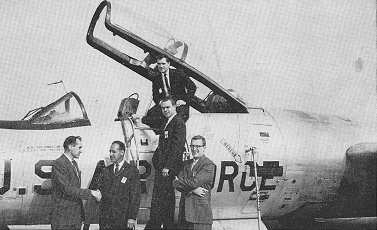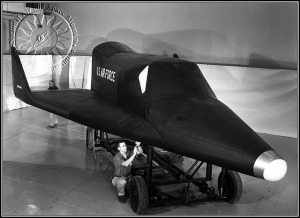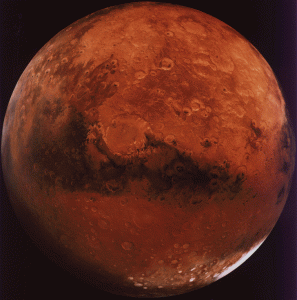 The latest budget for NASA for FY 2013 sees the agency’s Mars exploration program taking a huge hit – it will get $318 million less than FY 2012. This funding cut has forced NASA to withdraw from the ExoMars, the joint mission with the European Space Agency designed to culminate with a sample return. Without NASA, ExoMars is left in pieces and ESA is hoping the Russian Space Agency Roscosmos will take NASA’s place. This partnership could be without payoff since neither country has had great luck with Mars, particularly Russia whose missions have been thwarted by the mythical galactic ghoul. NASA’s withdrawal brings other questions to the forefront as well, like whether the agency has lost its way and will it soon lose its prestige in space. My whole article on the subject was published yesterday on Nature’s Soapbox Science Blog. (Left, an artist’s concept of ESA’a Beagle 2 falling through the Martian atmosphere.)
The latest budget for NASA for FY 2013 sees the agency’s Mars exploration program taking a huge hit – it will get $318 million less than FY 2012. This funding cut has forced NASA to withdraw from the ExoMars, the joint mission with the European Space Agency designed to culminate with a sample return. Without NASA, ExoMars is left in pieces and ESA is hoping the Russian Space Agency Roscosmos will take NASA’s place. This partnership could be without payoff since neither country has had great luck with Mars, particularly Russia whose missions have been thwarted by the mythical galactic ghoul. NASA’s withdrawal brings other questions to the forefront as well, like whether the agency has lost its way and will it soon lose its prestige in space. My whole article on the subject was published yesterday on Nature’s Soapbox Science Blog. (Left, an artist’s concept of ESA’a Beagle 2 falling through the Martian atmosphere.)
Tag: Landing Systems
The Life and Times of Don McCusker
 I got an email from a reader a few months ago who was particularly pleased that an old post mentioned his father, Don McCusker. McCusker was a North American Aviation test pilot and one of the few men to fly the full scale Gemini manned Test Tow Vehicle (TTV), the full scale Gemini spacecraft mated to the paraglider wing. Some research in unusual places, and a fascinating correspondence with his wife Helena, gave me fairly good picture of McCusker’s life. So while my research isn’t quite finished, I thought I’d write a short overview of the very interesting life of a test pilot that almost no one knows about. (Left, the Martin-built B57 that was used in research and development tests of a guidance systems. Don McCusker is on top, at the time serving as manager of the simulated MACE program. USAF.)
I got an email from a reader a few months ago who was particularly pleased that an old post mentioned his father, Don McCusker. McCusker was a North American Aviation test pilot and one of the few men to fly the full scale Gemini manned Test Tow Vehicle (TTV), the full scale Gemini spacecraft mated to the paraglider wing. Some research in unusual places, and a fascinating correspondence with his wife Helena, gave me fairly good picture of McCusker’s life. So while my research isn’t quite finished, I thought I’d write a short overview of the very interesting life of a test pilot that almost no one knows about. (Left, the Martin-built B57 that was used in research and development tests of a guidance systems. Don McCusker is on top, at the time serving as manager of the simulated MACE program. USAF.)
Taking Gemini to the Moon
 Apollo 8 is usually synonymous with Christmas — at least among spaceflight enthusiasts. In 1968, NASA made the daring decision to send Apollo 8 into lunar orbit in the name of getting American men to the moon ahead of the Soviet Union. On Christmas eve, the crew – Frank Borman, Jim Lovell, and Bill Anders – famously read from the book of Genesis. (Left, an artist’s concept of Apollo 8 firing its main engine to return to Earth.)
Apollo 8 is usually synonymous with Christmas — at least among spaceflight enthusiasts. In 1968, NASA made the daring decision to send Apollo 8 into lunar orbit in the name of getting American men to the moon ahead of the Soviet Union. On Christmas eve, the crew – Frank Borman, Jim Lovell, and Bill Anders – famously read from the book of Genesis. (Left, an artist’s concept of Apollo 8 firing its main engine to return to Earth.)
Sent with only a Command and Service module, the mission is often considered one of NASA’s greatest risks of the space race. But there were other equally audacious lunar missions in the planning stages long before NASA had a viable mission with Apollo 8. As early as 1961, the agency considered sending men to the moon, and even landing them on the surface, with a Gemini spacecraft. Continue reading “Taking Gemini to the Moon”
MSL Sky Crane on Scientific American’s Guest Blog
 Regular readers of Vintage Space will know that I’m fascinated by landings – the challenges of both landing on Earth and on other planets. Within this latter vein, I’ve lately become completely mesmerized with the Mars Science Laboratory’s (MSL’s) Sky Crane. Finally, I’ve found a fantastic outlet for an article I’ve been wanting to write for months about the Sky Crane, where it came from, and how it works. With this pieces, I’m very pleased to be a contributing member to the Scientific American’ Guest Blog! Check out the full article, which includes a video of MSL’s recent launch, on Scientific American’s website. (Pictured, the Sky Crane lowering the SUV-sized rover Curiosity to the surface of Mars. Don’t you want to know all about it?)
Regular readers of Vintage Space will know that I’m fascinated by landings – the challenges of both landing on Earth and on other planets. Within this latter vein, I’ve lately become completely mesmerized with the Mars Science Laboratory’s (MSL’s) Sky Crane. Finally, I’ve found a fantastic outlet for an article I’ve been wanting to write for months about the Sky Crane, where it came from, and how it works. With this pieces, I’m very pleased to be a contributing member to the Scientific American’ Guest Blog! Check out the full article, which includes a video of MSL’s recent launch, on Scientific American’s website. (Pictured, the Sky Crane lowering the SUV-sized rover Curiosity to the surface of Mars. Don’t you want to know all about it?)
A History of the Dyna-Soar
 Over the last few days, I’ve been doing some research into the USAF Dyna-Soar or X-20 program, and its story is much more interesting than I realized. Like many of the unrealized programs of the early space age, its impact extends far beyond its immediate application. Dyna-Soar is typically referenced in passing as an upgraded version of the X-15, an aircraft capable of achieving orbiting, but this connection is misleading. Dyna-Soar came from an entirely different place than the X-15, and its story is much more complicated than a simple cancelled research program. (A worker inspects a full-scale mockup of Dyna-Soar. Reader’s Digest described the vehicle as a cross between a porpoise and a manta ray. Early 1960s. Photo: Smithsonian Air and Space Museum.) Continue reading “A History of the Dyna-Soar”
Over the last few days, I’ve been doing some research into the USAF Dyna-Soar or X-20 program, and its story is much more interesting than I realized. Like many of the unrealized programs of the early space age, its impact extends far beyond its immediate application. Dyna-Soar is typically referenced in passing as an upgraded version of the X-15, an aircraft capable of achieving orbiting, but this connection is misleading. Dyna-Soar came from an entirely different place than the X-15, and its story is much more complicated than a simple cancelled research program. (A worker inspects a full-scale mockup of Dyna-Soar. Reader’s Digest described the vehicle as a cross between a porpoise and a manta ray. Early 1960s. Photo: Smithsonian Air and Space Museum.) Continue reading “A History of the Dyna-Soar”
Before This Decade is Out: Robotic Mars Edition
 Decades make great sales tools. Kennedy used a decade timeframe to sell American on the moon in 1961. Robert Zubrin recently tried the same pitch and called for a manned mission to Mars by the end of a decade (Zubrin’s been pitching a decade-long manned Mars program since the 1980s to no avail). A decade is a nice round number, and when you’re at the start of a decade – like the year 1961 or 2011 – people (namely Congress and taxpayers) can easily contemplate the end of a decade as a timeframe. But it isn’t only large-scale manned programs that use a round decade as a sales tool. Recently, the National Research Council’s Committee on Planetary Science in cooperation with NASA released an outline of its planetary goals for the coming decade. Where Mars in concerned, there is a pretty impressive program in the works from 2012 to 2023. But unlike the moon landing, bottomless funding isn’t going to achieve the goals at any cost. Instead, the next decade on Mars (pictured) will face certain challenges to meet the decadal goal. Continue reading “Before This Decade is Out: Robotic Mars Edition”
Decades make great sales tools. Kennedy used a decade timeframe to sell American on the moon in 1961. Robert Zubrin recently tried the same pitch and called for a manned mission to Mars by the end of a decade (Zubrin’s been pitching a decade-long manned Mars program since the 1980s to no avail). A decade is a nice round number, and when you’re at the start of a decade – like the year 1961 or 2011 – people (namely Congress and taxpayers) can easily contemplate the end of a decade as a timeframe. But it isn’t only large-scale manned programs that use a round decade as a sales tool. Recently, the National Research Council’s Committee on Planetary Science in cooperation with NASA released an outline of its planetary goals for the coming decade. Where Mars in concerned, there is a pretty impressive program in the works from 2012 to 2023. But unlike the moon landing, bottomless funding isn’t going to achieve the goals at any cost. Instead, the next decade on Mars (pictured) will face certain challenges to meet the decadal goal. Continue reading “Before This Decade is Out: Robotic Mars Edition”
Before This Decade is Out
 As part of my ongoing interest and fascination with proposed manned missions to Mars, I finally made my way through Robert Zubrin’s ‘The Case for Mars’. In it, he outlines a plan for a mission called Mars Direct. Coming from the Mars Society, of which Zubrin is president, the mission outlines how we can get astronauts to Mars armed with everything they need for the journey, including a spare return vehicle. The plan was first proposed in the late 1980s; Zubrin’s ‘The Case for Mars’ was first published in 1996. In recent years, the Mars Society has become more forceful in its attempts to see Mars Direct (literally) take off. Zubrin has gone so far as to declare that we are now more prepared to go to Mars than we were to go to the Moon in 1961 when Kennedy pledged the nation to a landing on its surface. I’m not sure I agree. (An artist’s concept of a multi-manned mission after landing on Mars.) Continue reading “Before This Decade is Out”
As part of my ongoing interest and fascination with proposed manned missions to Mars, I finally made my way through Robert Zubrin’s ‘The Case for Mars’. In it, he outlines a plan for a mission called Mars Direct. Coming from the Mars Society, of which Zubrin is president, the mission outlines how we can get astronauts to Mars armed with everything they need for the journey, including a spare return vehicle. The plan was first proposed in the late 1980s; Zubrin’s ‘The Case for Mars’ was first published in 1996. In recent years, the Mars Society has become more forceful in its attempts to see Mars Direct (literally) take off. Zubrin has gone so far as to declare that we are now more prepared to go to Mars than we were to go to the Moon in 1961 when Kennedy pledged the nation to a landing on its surface. I’m not sure I agree. (An artist’s concept of a multi-manned mission after landing on Mars.) Continue reading “Before This Decade is Out”
Preparing Planetary Parachutes
 In previous posts I’ve talked a little about the challenges of landing on other planets. A planet’s unique composition and gravity have a major effect on a spacecraft’s entry into and descent through the atmosphere, as well as its landing on the surface – more simply, the spacecraft’s EDL. One central problem associated with interplanetary missions that has always fascinated me is the problem of testing EDL systems without being able to simulate the target planet’s environment. (Pictured, an artist’s concept of the Mars Pathfinder mission’s terminal descent and landing.)
In previous posts I’ve talked a little about the challenges of landing on other planets. A planet’s unique composition and gravity have a major effect on a spacecraft’s entry into and descent through the atmosphere, as well as its landing on the surface – more simply, the spacecraft’s EDL. One central problem associated with interplanetary missions that has always fascinated me is the problem of testing EDL systems without being able to simulate the target planet’s environment. (Pictured, an artist’s concept of the Mars Pathfinder mission’s terminal descent and landing.)
Take Mars for example. The planet’s atmosphere is one percent as thick as the Earth’s and Martian gravity is one-third that felt on Earth. It’s impossible to simulate these conditions. Individual systems can be tested separately in approximate environments, but the only time the whole system will go through the stages of EDL is when it arrives at Mars.
In looking up results from Martian EDL systems tests, I kept turning up information on parachutes. I’ve never thought any aspect of spaceflight was simple, but I also never thought parachutes were very interesting. Turns out they are. For the moment, I’m going to limit myself to Mars landings and the Mars Science Laboratory (MSL) in particular. Set to launch in November 2011, MSL will use the brilliant yet frighteningly complex Sky Crane landing system to deliver the rover Curiosity to the surface.
But if the Sky Crane is going to have a chance to do its job, the whole MSL payload is going to have to enter the atmosphere and slow to a speed where its retrorockets can take over. That is the job of its parachute. Continue reading “Preparing Planetary Parachutes”
Rogallo After Gemini
 In a previous post, I looked at the Rogallo paraglider wing landing system and its failed development as part of NASA’s Gemini program. I also mentioned that the landing system didn’t disappear right away. After its cancellation from Gemini, NASA attempted to salvage its research and incorporate the landing system in Apollo and its follow-up programs. The US Air Force also expressed interest in including the Rogallo wing into its own space program. Regardless of the extra attention, it would seem that the paraglider was doomed to never leave the ground. (Left, a model Gemini capsule with Rogallo wing in a wind tunnel test. 1961.) Continue reading “Rogallo After Gemini”
In a previous post, I looked at the Rogallo paraglider wing landing system and its failed development as part of NASA’s Gemini program. I also mentioned that the landing system didn’t disappear right away. After its cancellation from Gemini, NASA attempted to salvage its research and incorporate the landing system in Apollo and its follow-up programs. The US Air Force also expressed interest in including the Rogallo wing into its own space program. Regardless of the extra attention, it would seem that the paraglider was doomed to never leave the ground. (Left, a model Gemini capsule with Rogallo wing in a wind tunnel test. 1961.) Continue reading “Rogallo After Gemini”
Losing Rogallo from Gemini
 Landing methods and the Gemini program are two of my favourite topics, and I’ve previously posted about landing methods in Gemini. The Mercury program demonstrated sufficient reason to move away from splashdowns, and the second generation Gemini manned spaceflight program gave NASA an opportunity to do so – it was the first to actively pursue a pilot-controlled land landing system. NASA reviewed multiple proposals before selecting the Rogallo paraglider wing. (Left, a model Gemini spacecraft with a Rogallo wing. 1963.)
Landing methods and the Gemini program are two of my favourite topics, and I’ve previously posted about landing methods in Gemini. The Mercury program demonstrated sufficient reason to move away from splashdowns, and the second generation Gemini manned spaceflight program gave NASA an opportunity to do so – it was the first to actively pursue a pilot-controlled land landing system. NASA reviewed multiple proposals before selecting the Rogallo paraglider wing. (Left, a model Gemini spacecraft with a Rogallo wing. 1963.)
Beginning with its initial development in 1961, the Rogallo wing had a long and interesting history within NASA. For the moment, I will limit myself to its inclusion in Gemini, putting the system’s research and development timeline against the Gemini program as a whole. This will begin to unravel why, in spite of NASA’s best efforts, all Gemini missions ended in splashdown. Continue reading “Losing Rogallo from Gemini”
